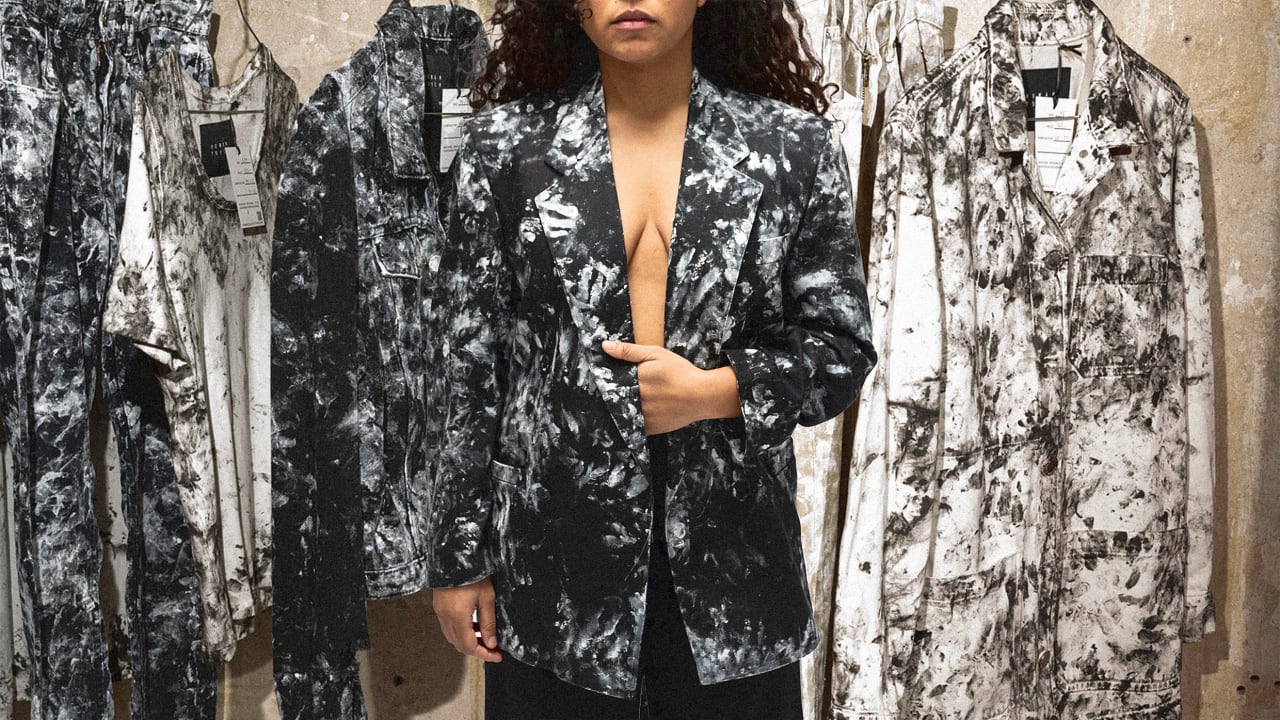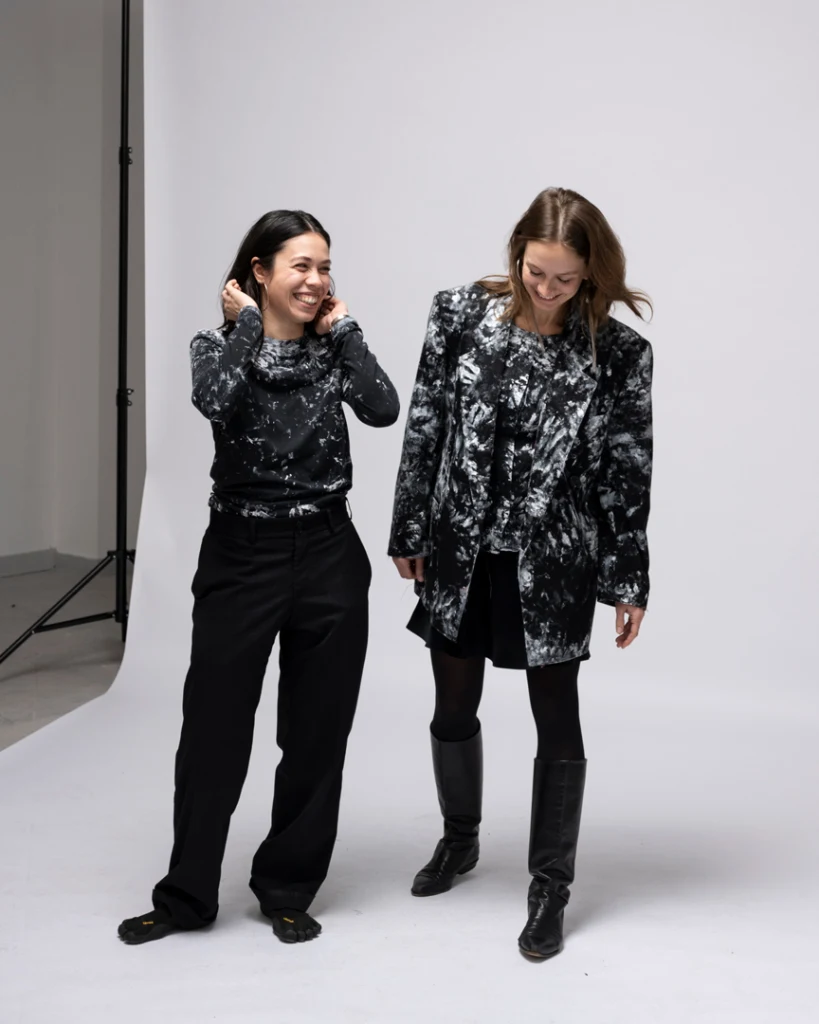These smudge marks show exactly where human hands touched your clothes while making them
Clothes don’t make themselves. Robots can cut, print, or dye fabrics, but they still can’t sew as well as humans, which means that every garment in your wardrobe was sewn by a pair of hands pinching and pushing a piece of fabric through a sewing machine. The problem is: how often do you think about that? Juliet Seger is a Berlin-based tailor, clothing engineer, and designer. She thinks that fast fashion and its globalized supply chain have desensitized us to the exploitation of labor associated with mass production. In the process, we have forgotten the simple fact that our clothes are made by real humans, who are the linchpin of the garment industry. To remind us, she has founded a brand called Human Touch, which uses a technique called paint-sewing to help visualize the human labor behind every T-shirt and pair of jeans. [Photo: Paula Reschke/Fashion Positions/courtesy Human Touch] Paint-sewing is exactly what it sounds like: the sewer (i.e. the person sewing) dips their fingers in textile paint, then goes about their regular business pushing the fabric under the needle. They don’t change anything about their sewing process other than dipping their fingers in paint every so often, but the sheer act of sewing with paint on their fingers means that their every move is literally imprinted on the garment. This makes it virtually impossible for the person who ends up wearing a Human Touch T-shirt or coat to forget that it was made by human hands. The invisible becomes visible. [Photo: Paula Reschke/Fashion Positions/courtesy Human Touch] Fashion as art and education Human Touch stemmed from Seger’s dissertation project at the Edinburgh College of Art, and evolved into a fashion brand with the help of Christina Albrecht, a tailor, fashion designer and now cofounder of Human Touch. The brand officially launched at Berlin Fashion Week in February this year, with a collection of secondhand and vintage garments that Serger and Albrecht upcycled by using their paint-sewing technique. Since then, the so-called Remedy collection has regularly sold out, and the brand is planning to launch its first original collection in February 2025. But Human Touch isn’t just a fashion brand, and the team wants to combine business with education and art. The duo has been doing pop-up paint-sewing performances, where they sew in front of a small crowd, then later sell the garments with an accompanying QR code that links to photos of the performance. [Photo: Studio Mime/courtesy Human Touch] Seger says the paint they use is a water-based acrylic that bonds best with natural and cellulose-based fibers that are smooth and even. It washes off easily from the hands but not from the fabric because once they’re done with a garment, they heat it to set the paint. Seger likened the paint-sewing process to playing in a muddy sandpit: “At some point you roll in the sand because you just embrace it.” [Photo: Studio Mime/courtesy Human Touch] The resulting garments might look like they were worn while somebody was repainting their house, but the marks and smudges only betray the complexities of the sewing process. In a collared shirt, for example, the most smudges will appear on the collar because it is requires the most maneuvers: first you sew it from the inside, then you flip it, then you sew it from the outside, and then you attach it to the rest of the shirt. Luckily for Human Touch, the smudgy look overlaps nicely with preexisting trends like paint splatter jeans, but the underlying narrative has helped elevate Human Touch from a mere fashion label to an activist brand that advocates against the fast fashion movement and for more conscious consumption. As Seger puts it: “Human Touch is not a solution, it’s an aid to think through [these] things.”

Clothes don’t make themselves. Robots can cut, print, or dye fabrics, but they still can’t sew as well as humans, which means that every garment in your wardrobe was sewn by a pair of hands pinching and pushing a piece of fabric through a sewing machine. The problem is: how often do you think about that?
Juliet Seger is a Berlin-based tailor, clothing engineer, and designer. She thinks that fast fashion and its globalized supply chain have desensitized us to the exploitation of labor associated with mass production. In the process, we have forgotten the simple fact that our clothes are made by real humans, who are the linchpin of the garment industry. To remind us, she has founded a brand called Human Touch, which uses a technique called paint-sewing to help visualize the human labor behind every T-shirt and pair of jeans.

Paint-sewing is exactly what it sounds like: the sewer (i.e. the person sewing) dips their fingers in textile paint, then goes about their regular business pushing the fabric under the needle. They don’t change anything about their sewing process other than dipping their fingers in paint every so often, but the sheer act of sewing with paint on their fingers means that their every move is literally imprinted on the garment. This makes it virtually impossible for the person who ends up wearing a Human Touch T-shirt or coat to forget that it was made by human hands. The invisible becomes visible.

Fashion as art and education
Human Touch stemmed from Seger’s dissertation project at the Edinburgh College of Art, and evolved into a fashion brand with the help of Christina Albrecht, a tailor, fashion designer and now cofounder of Human Touch. The brand officially launched at Berlin Fashion Week in February this year, with a collection of secondhand and vintage garments that Serger and Albrecht upcycled by using their paint-sewing technique. Since then, the so-called Remedy collection has regularly sold out, and the brand is planning to launch its first original collection in February 2025.
But Human Touch isn’t just a fashion brand, and the team wants to combine business with education and art. The duo has been doing pop-up paint-sewing performances, where they sew in front of a small crowd, then later sell the garments with an accompanying QR code that links to photos of the performance.

Seger says the paint they use is a water-based acrylic that bonds best with natural and cellulose-based fibers that are smooth and even. It washes off easily from the hands but not from the fabric because once they’re done with a garment, they heat it to set the paint. Seger likened the paint-sewing process to playing in a muddy sandpit: “At some point you roll in the sand because you just embrace it.”

The resulting garments might look like they were worn while somebody was repainting their house, but the marks and smudges only betray the complexities of the sewing process. In a collared shirt, for example, the most smudges will appear on the collar because it is requires the most maneuvers: first you sew it from the inside, then you flip it, then you sew it from the outside, and then you attach it to the rest of the shirt.
Luckily for Human Touch, the smudgy look overlaps nicely with preexisting trends like paint splatter jeans, but the underlying narrative has helped elevate Human Touch from a mere fashion label to an activist brand that advocates against the fast fashion movement and for more conscious consumption. As Seger puts it: “Human Touch is not a solution, it’s an aid to think through [these] things.”






















